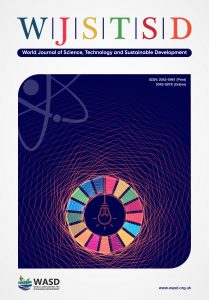Modeling the decision-making process of financial path transition from entrepreneur’s perspective using a fuzzy cognitive mapping, Dr. Anji Benhamed, Dr. Said Hajjar, Fatima Yaseen and Noamen Amara
Dr. Anji Benhamed
Higher Colleges of Technology, Al Ain
United Arab Emirates
Email: anjibenhamed@gmail.com
Dr. Said EL Hajjar
Arts Sciences and Technology University in Lebanon, Beirut
Lebanon
Fatima Hamad Yaseen, Noamen Amara
Ministry of Education, Manama
Bahrain
DOI: 10.1108/WJSTSD-04-2021-0046
Purpose: This study explores how entrepreneurs modify their financial path(s) and go beyond job security to attain greater financial freedom. The present work examines the cash-flow quadrant (CFQ) attributes and demonstrates the importance of the push-pull factors for an individual's quadrant transition in achieving financial freedom.
Design/methodology/approach: A hypothetical model and an abductive approach were used through regression models in a population sample of 260 Bahraini entrepreneurs. Fuzzy participatory cognitive mapping was also used to develop a conceptual model of financial path transition's decision making among entrepreneurs and study the impact of certain push-pull factors on the entrepreneurs' decisions.
Findings: The triangulated study identifies six categories of variables: financial freedom, workplace condition, independence, salary level, family life-building and retirement savings as key pull-push factors that significantly impact financial path transition's decision. Fuzzy cognitive mapping (FCM) extends our knowledge of the dynamics of CFQ transitions from a push-pull factor perspective. The results indicate no significant differences between the variables listed in the regression model and the fuzzy cognitive map model. Four categories of pull-push factors appeared as the entrepreneurs' top rankings when ordered by complexity, centrality scores and impact weight. These categories were workplace conditions, financial freedom, independence and salary level. The findings widen the scope of knowledge of each quadrant and rationalize how and why such factors impact quadrant decisions among Bahraini entrepreneurs.
Originality/value: Many studies discuss the CFQ model and consider its quadrants a specific method for identifying a unique financial path to generate income. A shifting quadrant occurs when individuals want to change their financial path and move beyond job security to achieve more financial freedom. Although this transition is well-established in the literature, the factors accounting for the individual's transition across quadrants have not received enough attention. This study fills this gap and calls for more in-depth investigations of this area to better understand the dynamics of CFQ transitions from a push-pull factor perspective.
Keywords: Cash-flow quadrant; Push-pull factors; Quadrant transition decision; Entrepreneur's decisions; Financial freedom; Dynamic financial path; Fuzzy cognitive mapping.
Citation: Benhamed, A., EL Hajjar, S., Hamad Yaseen, F. and Amara, N. (2021), "Modeling the decision-making process of financial path transition from entrepreneur's perspective using a fuzzy cognitive mapping", World Journal of Science, Technology and Sustainable Development, Vol. 18 No. 4, pp. 351-372. https://doi.org/10.1108/WJSTSD-04-2021-0046

